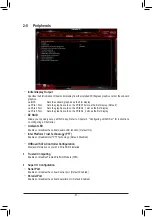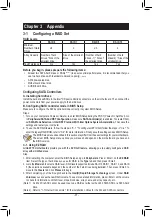
Chapter 3 Appendix
3-1 Configuring a RAID Set
Before you begin, please prepare the following items:
•
At least two SATA hard drives or SSDs
(Note 1)
(to ensure optimal performance, it is recommended that you
use two hard drives with identical model and capacity).
(Note 2)
•
A Windows setup disk.
•
Motherboard driver disk.
•
A USB thumb drive.
Configuring SATA Controllers
A. Installing hard drives
Install the hard drives/SSDs in the Intel
®
Chipset controlled connectors on the motherboard. Then connect the
power connectors from your power supply to the hard drives.
B. Configuring SATA controller mode in BIOS Setup
Make sure to configure the SATA controller mode correctly in system BIOS Setup.
Steps:
1. Turn on your computer and press <Delete> to enter BIOS Setup during the POST (Power-On Self-Test). Go
to
Peripherals\SATA And RST Configuration
, make sure
SATA Controller(s)
is enabled. To create RAID,
set
SATA Mode Selection
to
Intel RST Premium With Intel Optane System Acceleration
. Then save the
settings and restart your computer.
2.
To use the EZ RAID feature, follow the steps in "C-1." To configure UEFI RAID, follow the steps in "C-2." To
enter the legacy RAID ROM, refer to "C-3" for more information. Finally, save the settings and exit BIOS Setup.
The BIOS Setup menus described in this section may differ from the exact settings for your motherboard.
The actual BIOS Setup menu options you will see shall depend on the motherboard you have and
the BIOS version.
RAID Levels
(Note 1) An M.2 PCIe SSD cannot be used to set up a RAID set either with an M.2 SATA SSD or a SATA hard
drive.
(Note 2) Refer to "1-7 Internal Connectors," for the installation notices for the M.2 and SATA connectors.
C-1. Using EZ RAID
GIGABYTE motherboards provide you with the EZ RAID feature, allowing you to quickly configure a RAID
array with simplified steps.
Step:
1. After restarting the computer, enter the BIOS Setup and go to
Peripherals
. Press <Enter> on the
EZ RAID
item. Select the type of hard drives you use for RAID in the
Type
tab and then press <Enter>.
2. Go to the
Mode
tab to select a RAID level. RAID levels supported include RAID 0, RAID 1, RAID 10, and RAID
5 (the selections available depend on the number of the hard drives being installed). Then press <Enter> to
move to the
Create
tab. Click
Proceed
to begin
3. After completing, you'll be brought back to the
Intel(R) Rapid Storage Technology
screen. Under
RAID
Volumes
you can see the new RAID volume. To see more detailed information, press <Enter> on the volume
to check for information on RAID level, stripe block size, array name, and array capacity, etc.
RAID 0
RAID 1
RAID 5
RAID 10
Minimum
Number of Hard
Drives
≥2
2
≥3
4
Array Capacity Number of hard
drives * Size of the
smallest drive
Size of the smallest
drive
(Number of hard
drives -1) * Size of
the smallest drive
(Number of hard
drives/2) * Size of the
smallest drive
Fault Tolerance
No
Yes
Yes
Yes
- 37 -
Summary of Contents for GA-H270-HD3
Page 42: ... 42 ...
Page 43: ... 43 ...








































